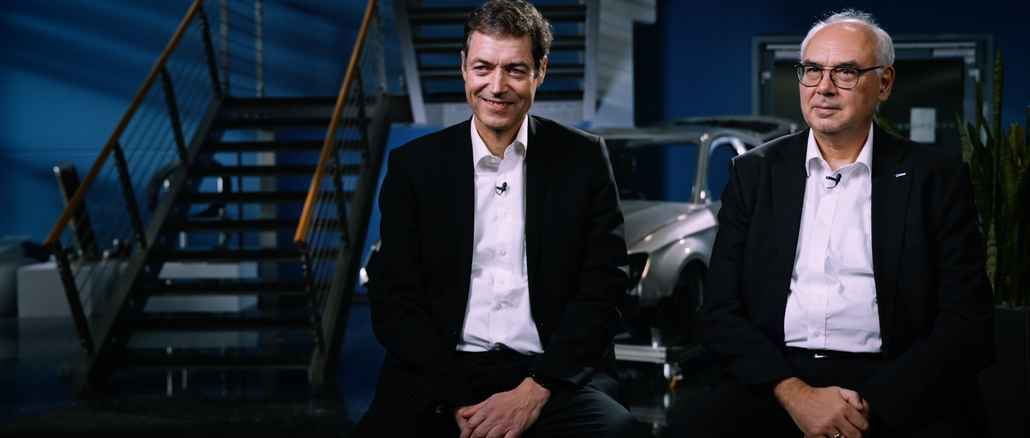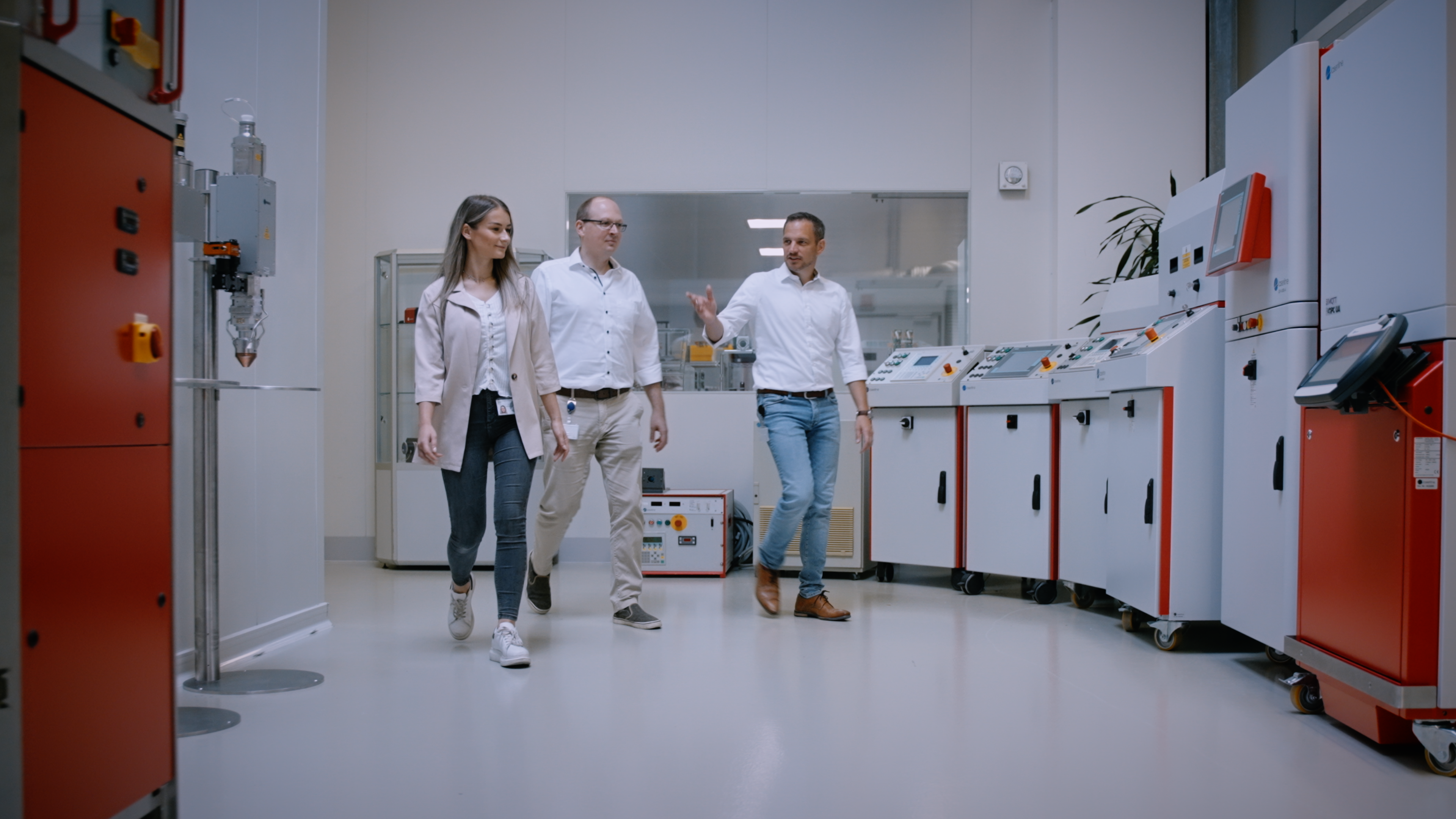
A tenacious duo: Anyone who experiences Laserline founders and managing directors Dr. Christoph Ullmann and Volker Krause together quickly realizes that the two are a well-coordinated team. When they founded the company in 1997, they started as a two-man engineering firm. Today, Laserline has 350 employees and is an international market-leading manufacturer of diode lasers for industrial applications such as welding, coating or 3D metal printing. What the journey there was like and how it will continue is explained by both of them in our interview.

© Laserline
The fact that the diode laser could one day be suitable for industrial use – hardly anyone had that in mind when you founded Laserline 25 years ago. What made you decide to rely on precisely this technology?
Krause: In a way, I was very lucky to be in the right place at the right time: After studying mechanical engineering, I led a first diode laser project at the Fraunhofer Institute for Laser Technology in Aachen from 1990 to 1994. The results of the project convinced me that the diode laser was a future-oriented technology – and that its possibilities would go far beyond the applications in consumer electronics or event technology that were known at the time.
Ullmann: It was clear to us from the beginning that the diode laser is an interesting tool for material processing. In addition, there was no company on the market specializing in diode lasers at that time. With Laserline, we were able to fill this gap in the market.
What exactly was your goal?
Krause: To build an industrial laser that can, in perspective, replace the lamp-pumped solid-state laser. We were sure that we would succeed with our diode lasers – and we did in the end.
Which of you two actually had the idea to start the company?
Ullmann: That was Volker Krause. He approached me with the idea at the time. I didn’t know the technology at the time, but promised to look into it. And I quickly realized: Yes, there is potential behind it.

© Laserline
When you think back to the early days – what do you remember most?
Krause: We approached the whole thing very “shirt-sleeved” and developed our first products within five months in 1997 to present them in Munich at Laser World of Photonics.
Ullmann: When the booth was booked, the company didn’t even have a name. We were very frugal in the early years and always had our eye on the numbers. We wanted to spend only what was necessary for our first trade show. So we slept in friends’ sleeping bags in Munich and then marched to the trade fair in the morning in our suits.
How did market participants react to the presentation of the first diode lasers?
Krause: Although we presented, among other things, the world’s first diode laser with one kilowatt of power at the trade show, we were initially met with a great deal of incomprehension. We were even asked what we wanted with this “better flashlight” …
Ullmann: … but just two years later, we achieved a breakthrough with this new technology: At the 1999 laser trade show, we demonstrated a cutting application for the first time using a new fiber-coupled 500-watt diode laser. This was a real sensation, because there was nothing comparable on the market at that time. Compared to the established solid-state and CO2 laser systems, diode lasers were not considered competitive at the time.
Today, a quarter of a century later, Laserline is one of the leading international developers and manufacturers of diode lasers for industrial material processing and is represented in a wide range of industries. After the breakthrough in 1999, what were the most important milestones in the company’s development?
Ullmann: In 2002, we moved into our own premises in Mülheim-Kärlich, thus laying the foundation for continuous growth. From a technological point of view, the next major milestone was then certainly the use of a diode laser in the automotive industry. In 2003/2004, our lasers were used for the first time to solder a tailgate, and later this application was also transferred to the roof seam. Today, about 1000 systems of this type are in use worldwide.
Krause: Another important step was undoubtedly our entry into additive manufacturing. Here, for the first time, we have developed products such as processing and powder heads for applications such as powder cladding. This led us away from pure laser beam generation. Today, we offer our customers complete system solutions – that is, beam source, beam guidance and processing optics come from a single source.
What role did research projects actually play in the development of your company? You originally come from a research background yourself, have repeatedly participated in research initiatives with Laserline in the past and are also currently involved in several research projects.
Ullmann: Research has been and will always be part of our corporate philosophy. In doing so, we not only research customized solutions, but also pursue new approaches for which there are currently no applications at all. Our blue laser, for example, was also created in this way.

© Laserline
This laser has caused quite a stir in the market and was undoubtedly one of the most important Laserline innovations in the recent past. How exactly did the development of such a diode laser in the blue wavelength spectrum come about and where do you see the most important areas of application?
Ullmann: Around 2015, it became apparent that it would soon be possible to produce powerful lasers in the wavelength range of 400 to 500 nanometers. We pursued this approach in a research project funded by the German Federal Ministry of Education and Research and presented a first prototype of a blue laser in 2017. Today, we offer blue lasers with an output of up to three kilowatts. We have also closed a gap in the market with this, because blue laser light is particularly suitable for processing highly reflective metals such as copper, aluminum and gold due to its very good absorption properties. Infrared light based processing of such materials is much more difficult due to poor absorption.
Overall, however, the infrared range still dominates diode lasers. Which areas of application are currently the most important here?
Krause: On the one hand, of course, the classic areas of application such as in the automotive and semiconductor industries. On the other hand, infrared diode lasers have also been shown to be very suitable for novel applications such as carbon fiber applications. In this process, plastic-carbon fiber ribbons are heated with a diode laser so that any three-dimensional components, such as pipes, ship hulls or aircraft wings, can be formed.
What is the current priority in the technological development of diode lasers and which application scenarios do you want to open up with them?
Krause: Laserline systems are known for their reliability and durability. But we are not resting on our laurels; we want to continue to improve. Our customers don’t buy a laser to throw it away after two years of use – they currently achieve runtimes of up to 50,000 hours with our diode laser systems. We would like to increase this already exceptionally long service life even further in the future.
Ullmann: In addition, we also want to continuously increase our performance. Twenty-five years ago, we started with an output power of 30 to 50 watts per laser component; today, an identical component delivers ten times that power, or about 300 watts. In the prototype area, we are currently already working with outputs of 60 kilowatts CW. In addition, pulse lasers with an output of over 100 kilowatts will also be available in the future.
How is Laserline actually reacting to the increasing digitalization of industrial processes, keyword: Industry 4.0?
Krause: We launched the first pilot projects very early on, which allow our customers to record and analyze process data in detail, for example. And we ensure that our products have the necessary digital interfaces to fully meet the requirements of industrial production lines, among other things.
What would you consider your company’s greatest strength?
Ullmann: Laserline stands out for its customer orientation. Our strength is to precisely understand the requirements of an application and to develop and implement customized solutions in close cooperation with our customers.
Laserline now has a total of eight foreign subsidiaries. What role does this international presence play?
Krause: It is an essential part of our success. We positioned ourselves internationally very early on and opened our first branch office in the USA back in the mid-2000s. Today, we have branches in the most important industrialized countries – i.e., in addition to the U.S., also in Japan, South Korea, India and China – and now sell the majority of our beam sources there. The focus of our subsidiaries is on sales as well as service and maintenance. Development and production, however, will remain in Mülheim-Kärlich. The heart of Laserline beats here in Germany.
What has been the most important lesson for you as an entrepreneur in 25 years of Laserline?
Ullmann: We have learned that long-term work pays off. We have handled many projects in which we have seen that success does not come immediately, but that it can sometimes take years for success to materialize. But in the end, it pays to persevere and work on things for the long term.
Krause: This is also linked to the realization that it is important not to chase the markets. On the contrary, it’s better to pick innovative solutions that you can then develop with the perseverance needed to become a true leader in the long run.
A dual leadership is not always easy, as many an example from business and politics shows. What is the secret of your collaboration?
Ullmann: We have known each other for more than 35 years, studied together and are friends. Part of the secret of our success is certainly that we don’t have a strict separation of duties – which is why we still share an office today. We always make decisions together and thus find the best solutions.
Krause: It’s important that you know each other well and know what makes your partner tick. This way, fewer mistakes happen and you end up making better decisions.
What do you wish for the future of Laserline?
Krause: We are continuing to strive for healthy growth so that in the long term we can expand the number of employees from around 350 today to over 1,000.
Ullmann: We also want to continue to develop technologically. We are convinced that we can continue to inspire the market with new applications and solutions in the future.
Web:
www.laserline.com



